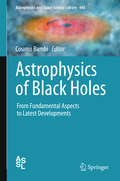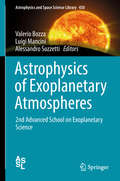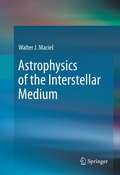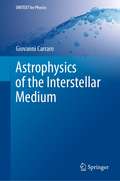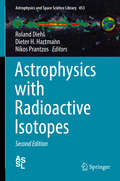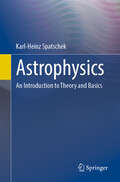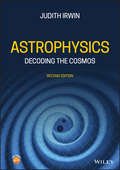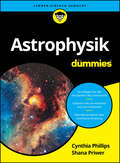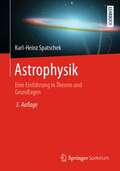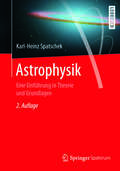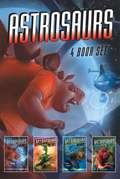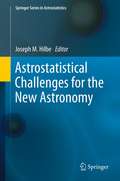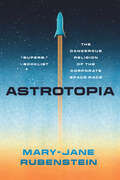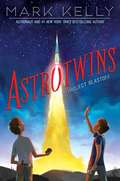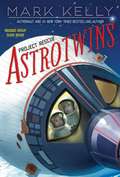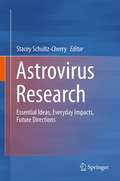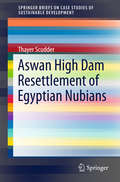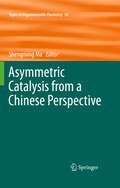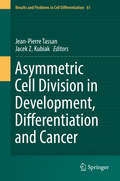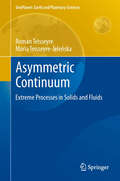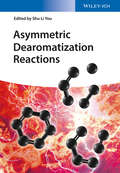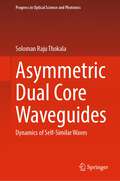- Table View
- List View
Astrophysics in a Nutshell
by Dan MaozA concise but thorough introduction to the observational data and theoretical concepts underlying modern astronomy, Astrophysics in a Nutshell is designed for advanced undergraduate science majors taking a one-semester course. This well-balanced and up-to-date textbook covers the essentials of modern astrophysics--from stars to cosmology--emphasizing the common, familiar physical principles that govern astronomical phenomena, and the interplay between theory and observation.In addition to traditional topics such as stellar remnants, galaxies, and the interstellar medium, Astrophysics in a Nutshell introduces subjects at the forefront of modern research, including black holes, dark matter, gravitational lensing, and dark energy, all updated with some of the latest observational results. To aid physical understanding, mathematical derivations are kept as simple, short, and clear as possible, and order-of-magnitude estimates, dimensional analysis, and scaling arguments are frequently used. These no-nonsense, "back-of-the-envelope" calculations train students to think like physicists. The book is amply illustrated with simple, clear figures and each chapter ends with a set of problems. In addition to serving as a course textbook, Astrophysics in a Nutshell is an ideal review for a qualifying exam and a handy reference for teachers and researchers.The most concise and up-to-date astrophysics textbook for science majors Contains a broad and well-balanced choice of traditional subjects and current research topics Uses simple, short, and clear derivations of physical results Trains students in the essential skills of order-of-magnitude analysis Includes teaching problems with each chapter
Astrophysics of Black Holes: From Fundamental Aspects to Latest Developments (Astrophysics and Space Science Library #440)
by Cosimo BambiThis book discusses the state of the art of the basic theoretical and observational topics related to black hole astrophysics. It covers all the main topics in this wide field, from the theory of accretion disks and formation mechanisms of jet and outflows, to their observed electromagnetic spectrum, and attempts to measure the spin of these objects. Black holes are one of the most fascinating predictions of general relativity and are currently a very hot topic in both physics and astrophysics. In the last five years there have been significant advances in our understanding of these systems, and in the next five years it should become possible to use them to test fundamental physics, in particular to predict the general relativity in the strong field regime. The book is both a reference work for researchers and a textbook for graduate students.
Astrophysics of Exoplanetary Atmospheres: 2nd Advanced School on Exoplanetary Science (Astrophysics and Space Science Library #450)
by Valerio Bozza Luigi Mancini Alessandro SozzettiIn this book, renowned scientists describe the complexity of exoplanetary atmospheres and all of the observational techniques that are employed to probe them. Readers will also find a panoramic description of the atmospheres of the planets within the Solar System, with explanation of considerations especially relevant to exoplanets. Over the past few years, thousands of exoplanets have been discovered orbiting around stars relatively close to the Solar System. Astronomers have revealed how varied these exoplanets are (rocky, icy, giant) and how diverse their architecture can be, confirming science fiction images in several cases and extending beyond the human imagination in others. The natural next step is to study their atmospheres and to understand their chemical composition and the physical processes taking place in their interiors, with the aim of detecting biomarkers. This book will appeal to all who seek a comprehensive, state-of-the-art account of the latest knowledge in the rapidly developing and highly interdisciplinary field of exoplanet research.
Astrophysics of Planet Formation
by Philip J. ArmitageConcise and self-contained, this textbook gives a graduate-level introduction to the physical processes that shape planetary systems, covering all stages of planet formation. Writing for readers with undergraduate backgrounds in physics, astronomy, and planetary science, Armitage begins with a description of the structure and evolution of protoplanetary disks, moves on to the formation of planetesimals, rocky, and giant planets, and concludes by describing the gravitational and gas dynamical evolution of planetary systems. He provides a self-contained account of the modern theory of planet formation and, for more advanced readers, carefully selected references to the research literature, noting areas where research is ongoing. The second edition has been thoroughly revised to include observational results from NASA's Kepler mission, ALMA observations and the JUNO mission to Jupiter, new theoretical ideas including pebble accretion, and an up-to-date understanding in areas such as disk evolution and planet migration.
Astrophysics of the Interstellar Medium
by Walter J. MacielThe space between the stars contains a large diversity of objects in which physical processes occur that are fundamental to the structure and evolution of galaxies. This book offers the reader a basic knowledge of these processes and presents simple numeric estimates of the main quantities relevant to the interstellar medium. The main objects that constitute the interstellar space are described, but the emphasis of the book lies in the physical processes occurring in these objects, which may also occur in other astrophysical environments. The book is directed tor graduate as well as advanced undergraduate students of physics and astrophysics.
Astrophysics of the Interstellar Medium (UNITEXT for Physics)
by Giovanni CarraroThis book is based on a series of lectures for an Astrophysics of the Interstellar Medium (ISM) master’s degree in Astrophysics and Cosmology at Padova University. From the cold molecular phase in which stars and planetary systems form, to the very hot coronal gas that surrounds galaxies and galaxy clusters, the ISM is everywhere. Studying its properties is vital for the exploration of virtually any field in astronomy and cosmology. These notes give the student a coherent and accurate mathematical and physical approach, with continuous references to the real ISM in galaxies. The book is divided into three parts. Part One introduces the equations of fluid dynamics for a system at rest and acoustic waves, and then explores the real ISM through the role of thermal conduction and viscosity, concluding with a discussion of shock waves and turbulence. In Part Two, the electromagnetic field is switched on and its role in modulating shock waves and contrasting gravity is studied. Part Three describes dust and its properties, followed by the main stellar sources of energy. The last two chapters respectively address the various components of the ISM and molecular clouds and star formation.
Astrophysics with Radioactive Isotopes (Astrophysics and Space Science Library #453)
by Nikos Prantzos Roland Diehl Dieter H. HartmannDealing with astrophysics derived from the radiation emitted by radioactive atomic nuclei, this book describes the different methods used to measure cosmic radio-isotopes. It demonstrates how this astronomical window has contributed to the understanding of the sources and the chemical evolution of cosmic gas. Reference materials and explanations are included for students in advanced stages of their education.Nuclear reactions in different sites across the universe lead to the production of stable and unstable nuclei. Their abundances can be measured through different methods, allowing to study the various nuclear processes taking place in cosmic environments. Nucleosynthesis is the cosmic formation of new nuclear species, starting from hydrogen and helium resulting from the big bang origins. Stars create and eject synthesized nuclei during their evolution and explosions. Incorporation of the new interstellar composition into next-generation stars characterises the compositional (chemical) evolution of cosmic gas in and between galaxies. Radioactive species have unique messages about how this occurs. Since the first Edition of this book published in 2011 with the title Astronomy with Radioactivities, long-awaited new direct observations of supernova radioactivity have been made and are now addressed in two updated chapters dealing with supernovae. In this second Edition, the advances of recent years beyond one-dimensional treatments of stellar structure and stellar explosions towards 3-dimensional models have been included, and led to significant re-writings in Chapters 3-5. The sections on the Solar System origins have been re-written to account for new insights into the evolution of giant molecular clouds. The chapter on diffuse radioactivities now also includes material measurements of radioactivities in the current solar system, and their interpretations for recent nucleosynthesis activity in our Galaxy. Significant new results on gamma-rays from positron annihilations have been accounted for in that chapter, and led to new links with nucleosynthesis sources as well as interstellar transport processes. A new chapter now provides a description of interstellar processes often called 'chemical evolution', thus linking the creation of new nuclei to their abundance observations in gas and stars. The experimental / instrumental chapters on nuclear reaction measurements, on gamma-ray telescopes, and pre-solar grain laboratories have been updated. Moreover, new windows of astronomy that have been opened up in recent years have been included in the discussions of the multi-messenger approach that broadens the basis for astrophysical insights.
Astrophysics: An Introduction to Theory and Basics
by Karl-Heinz SpatschekThis textbook offers a comprehensible introduction to the physical fundamentals of the processes in our universe. The first chapters cover the observational possibilities of astrophysical quantities, cosmic rays, star formation and evolution, and galaxy formation and modeling. Subsequently, the basics of general relativity and different phenomena such as gravitational waves and black holes are covered. The book concludes with an introduction to cosmology: In addition to traditional homogeneous approaches, inhomogeneous cosmology in particular is given a broader scope in this new edition. Current inflationary models are presented. The book is intended for students of physics at the undergraduate, bachelor, and master levels, but it also offers a readable and easy-to-understand introduction for people with a basic knowledge of mathematics and physics who are interested in the natural sciences. ContentsSome important physical basics - observational possibilities - cosmic rays - stellar structure and stellar evolution - final stages of burning stars - galaxies - Newtonian cosmology - computational rules of ART - ART effects - relativistic stars and stellar dynamics - homogeneous cosmology - observations and interpretation approaches - inflation - inhomogeneous cosmology
Astrophysics: Decoding the Cosmos
by Judith Ann IrwinThe new edition of the popular textbook for undergraduate astronomers, covers the "how" of astrophysics Astrophysics: Decoding the Cosmos, Second Edition, describes how information about the physical nature of stars and other celestial bodies is obtained and analyzed to gain a better understanding of the universe. This acclaimed introductory textbook makes the complex principles and theories underlying astrophysics accessible to students with basic knowledge of first-year calculus-based physics and introductory astronomy. Reader-friendly chapters explore physical processes using relevant examples and clear explanations of how radiation and particles are analyzed. Such analysis leads to the density, temperature, mass, and energy of astronomical objects. In the time since the first publication of Astrophysics, the power of telescopes has increased considerably. Reflecting advancements in the field, this new edition includes carefully reviewed and updated material throughout, including recent GAIA satellite results, new information from subatomic particles, neutrinos, and cosmic rays, and brand-new case studies on Gamma-ray bursters, soft repeaters, fast radio bursts, exoplanets, and signals from exoplanetary atmospheres. Retaining its focus on electromagnetic radiation, the second edition now covers more of the ways that information about the universe is acquired, such as particles, gravitational radiation, and meteoritics. This textbook: Describes complex processes in a clear and accessible manner Provides relevant background information on the physics and examples of the theory in practice to place the subject into context Includes new figures, case studies, examples, further readings, end-of-chapter problems of varying difficulty levels, and open-ended "Just for Fun" problems Features a companion website containing information required to solve the designated web-based problems in the text and a range supplementary learning material Astrophysics: Decoding the Cosmos, Second Edition, is the ideal intermediate textbook for second- and third- year undergraduate students in Astrophysics courses, as well as a useful resource for advanced undergraduate and graduate students looking to refresh their knowledge in basic concepts.
Astrophysik für Dummies (Für Dummies)
by Cynthia Phillips Shana PriwerWo Astronomie und Physik zusammenkommen Was steckt hinter den Dingen, die wir am Himmel sehen – astronomische Objekte wie Sterne und Himmelskörper? Mit dieser Frage beschäftigt sich die Astrophysik. Dieses Buch erklärt leicht verständlich alles, was Sie brauchen, um ein grundlegendes Verständnis der Astrophysik zu erlangen, sei es für Ihr Studium oder aus Interesse. Cynthia Phillips führt Sie in die Welt der Sterne und Galaxien ein und nimmt Sie mit auf eine faszinierende Reise durchs Universum. Sie lernen die Wissenschaft hinter Sternensystemen, Schwarzen Löchern, Dunkler Materie und anderen Phänomen kennen. Es gibt so viel zu entdecken! Sie erfahren Was außer Sternen, Schwarzen Löchern und Exoplaneten das Universum bevölkert Welche Wissenschaftler die Astrophysik geprägt haben Wie alles begann und wie es vielleicht endet
Astrophysik: Eine Einführung in Theorie und Grundlagen
by Karl-Heinz SpatschekVon weißen Zwergen und schwarzen Löchern: Diese Einführung in Grundlagen und Theorie vermittelt anschaulich und kompakt ein Verständnis der Physik des Universums. Dargestellt werden die wichtigen physikalischen Modelle, mit denen die Sterne beschrieben werden können. Viele der faszinierenden Phänomene unseres Universums lassen sich so quantitativ untersuchen.
Astrophysik: Eine Einführung in Theorie und Grundlagen (Teubner Studienbücher Physik Ser.)
by Karl-Heinz SpatschekVon wei#65533;en Zwergen und schwarzen L#65533;chern: Diese Einf#65533;hrung in Grundlagen und Theorie vermittelt anschaulich und kompakt ein Verst#65533;ndnis der Physik des Universums. Dargestellt werden die wichtigen physikalischen Modelle, mit denen die Sterne beschrieben werden k#65533;nnen. Viele der faszinierenden Ph#65533;nomene unseres Universums lassen sich so quantitativ untersuchen.
Astrosaurs 4 Book Set
by Steve Cole Various ArtistsExplore space with dynamic dinos in this set of four out-of-this-world adventures.It turns out that dinosaurs, despite their itty-bitty brains, were really pretty smart. They managed to escape the Earth in spaceships long before the meteors hit, and now travel among the stars of the Jurassic Quadrant, exploring new worlds, fighting evil, and keeping space safe.This eBook boxed set includes four stellar Astrosaur adventures: Riddle of the Raptors, The Hatching Horror, The Seas of Doom, and The Mind-Swap Menace.
Astrostatistical Challenges for the New Astronomy (Springer Series in Astrostatistics #1)
by Joseph M. HilbeAstrostatistical Challenges for the New Astronomy presents a collection of monographs authored by several of the disciplines leading astrostatisticians, i.e. by researchers from the fields of statistics and astronomy-astrophysics, who work in the statistical analysis of astronomical and cosmological data. Eight of the ten monographs are enhancements of presentations given by the authors as invited or special topics in astrostatistics papers at the ISI World Statistics Congress (2011, Dublin, Ireland). The opening chapter, by the editor, was adapted from an invited seminar given at Los Alamos National Laboratory (2011) on the history and current state of the discipline; the second chapter by Thomas Loredo was adapted from his invited presentation at the Statistical Challenges in Modern Astronomy V conference (2011, Pennsylvania State University), presenting insights regarding frequentist and Bayesian methods of estimation in astrostatistical analysis. The remaining monographs are research papers discussing various topics in astrostatistics. The monographs provide the reader with an excellent overview of the current state astrostatistical research, and offer guidelines as to subjects of future research. Lead authors for each chapter respectively include Joseph M. Hilbe (Jet Propulsion Laboratory and Arizona State Univ); Thomas J. Loredo (Dept of Astronomy, Cornell Univ); Stefano Andreon (INAF-Osservatorio Astronomico di Brera, Italy); Martin Kunz ( Institute for Theoretical Physics, Univ of Geneva, Switz); Benjamin Wandel ( Institut d'Astrophysique de Paris, Univ Pierre et Marie Curie, France); Roberto Trotta (Astrophysics Group, Dept of Physics, Imperial College London, UK); Phillip Gregory (Dept of Astronomy, Univ of British Columbia, Canada); Marc Henrion (Dept of Mathematics, Imperial College, London, UK); Asis Kumar Chattopadhyay (Dept of Statistics, Univ of Calcutta, India); Marisa March (Astrophysics Group, Dept of Physics, Imperial College, London, UK).
Astrotopia: The Dangerous Religion of the Corporate Space Race
by Mary-Jane RubensteinA revealing look at the parallel mythologies behind the colonization of Earth and space—and a bold vision for a more equitable, responsible future both on and beyond our planet. As environmental, political, and public health crises multiply on Earth, we are also at the dawn of a new space race in which governments team up with celebrity billionaires to exploit the cosmos for human gain. The best-known of these pioneers are selling different visions of the future: while Elon Musk and SpaceX seek to establish a human presence on Mars, Jeff Bezos and Blue Origin work toward moving millions of earthlings into rotating near-Earth habitats. Despite these distinctions, these two billionaires share a core utopian project: the salvation of humanity through the exploitation of space. In Astrotopia, philosopher of science and religion Mary-Jane Rubenstein pulls back the curtain on the not-so-new myths these space barons are peddling, like growth without limit, energy without guilt, and salvation in a brand-new world. As Rubenstein reveals, we have already seen the destructive effects of this frontier zealotry in the centuries-long history of European colonialism. Much like the imperial project on Earth, this renewed effort to conquer space is presented as a religious calling: in the face of a coming apocalypse, some very wealthy messiahs are offering an other-worldly escape to a chosen few. But Rubenstein does more than expose the values of capitalist technoscience as the product of bad mythologies. She offers a vision of exploring space without reproducing the atrocities of earthly colonialism, encouraging us to find and even make stories that put cosmic caretaking over profiteering.
Astrotwins -- Project Blastoff
by Martha Freeman Mark KellyA team of middle schoolers prepares for blastoff in this adventure from the author of the New York Times bestselling Mousetronaut, based on the childhoods of real-life astronauts Mark Kelly and his twin brother Scott.It's a long, hot summer and Scott and Mark are in big trouble for taking apart (aka destroying) their dad's calculator. As a punishment, they're sent to their grandfather's house, where there's no TV and they have to do chores. And Grandpa is less tolerant of the twins' constant bickering. "Why don't you two work together on something constructive. What if you built a go-kart or something?" Grandpa suggests. But it's not a go-kart the twins are interested in. They want to build a rocket. With the help of Jenny, nicknamed Egg, and a crew of can-do kids, they set out to build a real rocket that will blast off and orbit the Earth. The question soon becomes: which twin will get to be the astronaut? Written by a NASA astronaut with four space flights under his belt, this exciting story includes extensive back matter on the space program with fantastic facts and details.
Astrotwins -- Project Rescue
by Martha Freeman Mark KellyTwins Mark and Scott discover an abandoned Apollo command module and take off to rescue a stranded Russian cosmonaut in the second Astrotwins adventure from retired NASA astronaut and the #1 New York Times bestselling author of Mousetronaut, Mark Kelly.Mark and Scott Kelly, who are mostly known for getting in trouble, are finally back from their first space adventure. The twins have wanted to explore space ever since they were little and watched Neil Armstrong walk on the moon. And when they hear that a Russian cosmonaut is trapped inside the Salyut space station now orbiting 220 miles above the surface of the Earth, they wish they could find a way to help. While staying in the countryside at their grandfather's house with their friend Jenny (aka Egg), the twins repurpose a NASA Titan 2 rocket ship being stored nearby. Complete with spacesuits and snacks, the twins take off to rescue the Russian spacecraft. Will they ever see their family or their grandfather's backyard again? Written by a NASA astronaut with four space flights under his belt, the second exciting Astrotwins story includes extensive back matter on the space program with fantastic facts and details.
Astrovirus Research: Essential Ideas, Everyday Impacts, Future Directions
by Stacey Schultz-CherryAstroviruses were first identified in the feces of children in 1975. Since then, they have been found in ~ 3 to 20% of children with diarrhea. Given that serological studies have demonstrated that up to 90% of children have been exposed to at least one strain of astrovirus by age 9, the prevalence of infection may be much higher. Supporting this are studies demonstrating that astroviruses can also be isolated in a subset of asymptomatic individuals, suggesting that a proportion of infected individuals shed the virus asymptomatically or for some time after the resolution of other symptoms of infection. Asymptomatic carriers may be a major reservoir for astroviruses in the environment and could contribute to dissemination of the virus. Astroviruses are extremely stable in the environment and can be transmitted nosocomially, directly from infected individuals and potentially animals, and through contaminated food and water. Although typically an acute disease, astrovirus infection in premature infants may be associated with the development of necrotizing enterocolitis and in new-onset celiac disease in children. Immunocompromised children are even more susceptible often developing persistent infections that lead to wasting or even systemic infections associated with fatal encephalitis. In spite of its importance, little is known about astrovirus pathogenesis, molecular biology, epidemiology, or cell biology. The goal of this book is to provide the latest and most up-to-date information on this medically important and rapidly evolving group of viruses. It will include sections on the history of astroviruses and their disease in humans; information on viral replication and immune responses; new information on how astroviruses induce disease including the expression of a viral enterotoxin regulating intestinal epithelial cell tight junctions, the isolation and identification of new astrovirus genotypes in mammals including humans, and astroviruses of veterinary importance. Finally, the book will also introduce the complexity of astrovirus epidemiology and potential as an important new zoonotic disease, and its role in food-borne disease. This will be the first book of its kind and will be of great interest to microbiologists, virologists, infectious disease specialists, immunologists, pediatricians, public health and food safety experts, veterinarians, poultry industry specialists, and researchers and clinicians interested in enteritis.
Aswan High Dam Resettlement of Egyptian Nubians (SpringerBriefs on Case Studies of Sustainable Development)
by Thayer ScudderThis book highlights the long-term resettlement process of the Egyptian Nubian people along the Aswan High Dam. Assessing the resettlement of 48,000 Egyptian Nubians in connection with the High Dam is especially important for three main reasons: firstly, this resettlement process is one of the rare cases in which research begun before the dam was built has continued for over forty years. Secondly, the resettlement of the Egyptian Nubian people is one of the few cases in which the living standards of the large majority improved because of the initial political will of the government, combined with Nubian initiatives. Thirdly, given the complexity of the resettlement process, weaknesses in government planning, implementation, and in the weakening of government political provide valuable lessons for future dam-induced resettlement efforts.
Asymmetric Catalysis from a Chinese Perspective (Topics in Organometallic Chemistry #36)
by Shengming MaQi-Lin Zhou and Jian-Hua Xie: Chiral Spiro Catalysts.- Fuk Loi Lam, Fuk Yee Kwong and Albert S. C. Chan: Chiral Phosphorus Ligands with Interesting Properties and Practical Applications.- Jiang Pan, Hui-Lei Yu, Jian-He Xu, Guo-Qiang Lin: Advances in Biocatalysis: Enzymatic Reactions and Their Applications.- Mei-Xiang Wang: Enantioselective Biotransformations of Nitriles.- Man Kin Wong, Yiu Chung Yip and Dan Yang: Asymmetric Epoxidation Catalyzed by Chiral Ketones.- W. J. Liu, N. Li and L. Z. Gong: Asymmetric Organocatalysis.- Qing-Hua Fan and Kuiling Ding: Enantioselective Catalysis with Structurally Tunable Immobilized Catalysts.- Chang-Hua Ding, Xue-Long Hou: Transition Metal-Catalyzed Asymmetric Allylation.- Jian Zhou and Yong Tang: Enantioselective Reactions with Trisoxazolines.- Xiang-Ping Hu, Duo-Sheng Wang, Chang-Bin Yu, Yong-Gui Zhou, and Zhuo Zheng: Adventure in Asymmetric Hydrogenation: Synthesis of Chiral Phosphorus Ligands and Asymmetric Hydrogenation of Heteroaromtics.
Asymmetric Catalysis on Industrial Scale: Challenges, Approaches and Solutions
by Hans-Ulrich Blaser et al.This second edition of the pioneering work on this hot topic captures the major trends and latest achievements in the art of asymmetric catalysis on an industrial scale. A number of completely new real-life case studies written by the world leaders in their respective areas provide a compact and qualified insight into this developing field. The resulting ready reference and handbook collates first-hand and valuable information within a context where it can be easily found. The high-quality contributions illustrate the relevant environments and situations, such as time pressure, how the catalytic step fits into the overall synthesis, or competition with other synthetic approaches, as well as the typical problems encountered in the various phases, including finding/developing the catalyst and optimization of the process or choice of equipment. Both successful and unsuccessful approaches to solve these problems are described.
Asymmetric Cell Division in Development, Differentiation and Cancer (Results and Problems in Cell Differentiation #61)
by Jacek Z. Kubiak Jean-Pierre TassanThis book provides readers with an overview of the frequent occurrence of asymmetric cell division. Employing a broad range of examples, it highlights how this mode of cell division constitutes the basis of multicellular organism development and how its misregulation can lead to cancer. To underline such developmental correlations, readers will for example gain insights into stem cell fate and tumor growth. In turn, subsequent chapters include descriptions of asymmetric cell division from unicellular organisms to humans in both physiological and pathological conditions. The book also illustrates the importance of this process for evolution and our need to understand the background mechanisms, offering a valuable guide not only for students in the field of developmental biology but also for experienced researchers from neighboring fields.
Asymmetric Continuum: Extreme Processes in Solids and Fluids (GeoPlanet: Earth and Planetary Sciences #3)
by Roman Teisseyre Maria Teisseyre-JeleńskaThis book deals with a class of basic deformations in Asymmetric Continuum Theory. It describes molecular deformations and transport velocities in fluids, strain deformations in solids as well as the molecular transport, important in fracture processes. In solids, a separate problem relates to the displacements; their recording, e. g. , by means of the seismometers, proves only the existence of the displacement derivatives and not a real displacement. However, the molecular displacements and new fracture criterion including the defect distributions and induced strains are defined in the book too. In fluids, the transport velocities and molecular strains describe the motion processes. The vortex motions are defined by means of the rotational transport; this approach leads to more complicated problems, like the turbulence phenomena. The interaction processes, including the electric and magnetic fields, and some thermodynamical problems and quantum theory analogies help to understand the extreme processes
Asymmetric Dearomatization Reactions
by Shu-Li YouThe first comprehensive account of the rapidly growing field of asymmetric dearomatization reactions with a focus on catalytic methods. It introduces the concept of dearomatization and describes recent progress in asymmetric reaction procedures with different catalyst systems, such as organocatalysts, transition metal catalysts, and enzymes. Chapters on dearomatizations of electron-deficient aromatic rings, dearomatization reactions via transition metal-catalyzed cross-couplings as well as dearomatization strategies in the synthesis of complex natural products are also included. Written by pioneers in the field, this is a highly valuable source of information not only for professional synthetic chemists in academia and industry but also for all those are interested in asymmetric methodologies and organic synthesis in general.
Asymmetric Dual Core Waveguides: Dynamics of Self-Similar Waves (Progress in Optical Science and Photonics #22)
by Soloman Raju ThokalaThis book highlights the dynamical behavior of self-similar waves in asymmetric dual-core waveguides. The proposed dual-core waveguide consists of two closely spaced adjoining fibers in which one fiber is active and the other is passive. Due to the linear coupling between them, the dynamics of the wave propagating through the passive core can be controlled by manipulating the dynamics of the wave propagating in the active core. The optimal pulse compression or amplification of these waves as the length of the fiber tends to infinity is presented. The exact Mobius transform self-similar solutions that propagate through these waveguides self-similarly are subject to simple scaling rules. The book includes experiments conducted to corroborate the analytical predictions.

